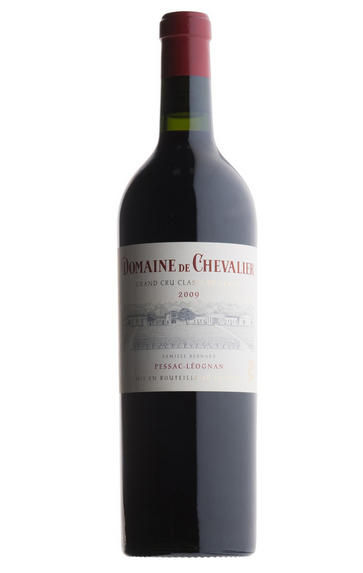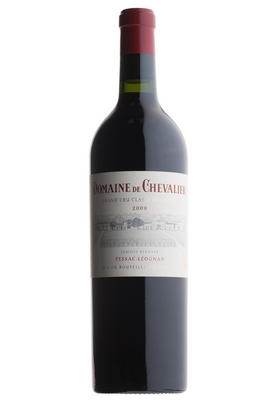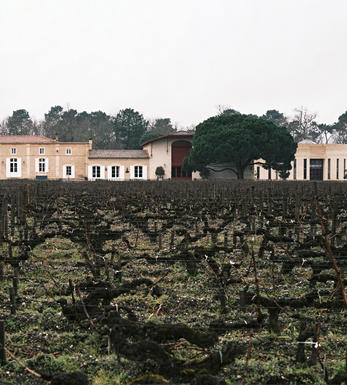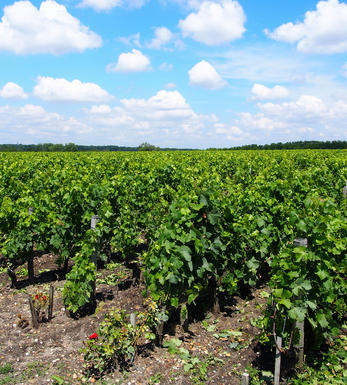
2009 Domaine de Chevalier, Pessac-Léognan, Bordeaux

Critics reviews
Tasted blind at the Domaine de Chevalier vertical at the property.
The 2009 Domaine de Chevalier has a vivacious, almost exotic bouquet with lavish black fruit, mint, oregano and cedar that all gain intensity with aeration. The palate is medium-bodied with supple tannin, a fine bead of acidity, ripe black fruit laced with white pepper and even a faint touch of Szechuan pepper. This displays exquisite balance and the finish feels deep and satisfying, clearly born in a great vintage.
Drink 2021 - 2050
Neal Martin, Vinous.com (March 2019)
Inky purple. Fresh, clean, rather delicate aromas of blackcurrant, violet, damp moss, leather and minerals are sweetened by a red cherry note. Smooth and soft, with very ripe strawberry syrup and blackberry flavours. Offers a fleshy quality that's supported by the stoniness typical of Chevalier. Nicely balanced, minerally and long, leaving behind a note of gunflint. I would not be at all surprised if this evolves in bottle to merit a score at the high end of my projected range.
Ian D'Agata, Vinous.com (May 2010)
Remains deep damson in colour even at nearly 10 years old, and on the attack you find full and true blackberry cassis and bilberry notes, we are really building up layers and complexity on the nose. Gorgeous wine, just beautiful balance and juiciness, and a silken texture to the fruit, tannins that support without ever being intrusive, no question this can age. Tannins are deceptive because they build over the palate. Tobacco and walnut on the finish, I look forward to watching this develop further over the next few years.
Drink 2019 - 2035
Jane Anson, JaneAnson.com (April 2018)
In late 2011, I had the last bottle in my cellar of the 1970 Domaine de Chevalier. Much to my surprise, it was still holding on to life and remained gorgeously complex in that ethereal Graves style. The 2009, one of the finest Domaine de Chevaliers yet produced, reveals a striking bouquet of burning embers, sweet cherry, black and red currant fruit, spice box, cedar and lead pencil shavings. The tannins are sweet in this fleshy, full-bodied offering. It is built on the notion of extraordinary harmony, elegance and complexity.
While not the most concentrated or flamboyant 2009, its intense aromas are already reasonably evolved and its lusciousness and balance are terrific. Made from an interesting blend of 64% Cabernet Sauvignon, 30% Merlot and 6% Petit Verdot, its yields of 45 hectoliters per hectare were slightly higher than many of its neighbors achieved. Drink it over the next 25 years.
Drink 2012 - 2037
Robert M. Parker, Jr., Wine Advocate (December 2011)
66% Cabernet Sauvignon, 28% Merlot, 6% Petit Verdot. Harvested 24 September to 14 October.
Crimson hue. Subtle dark fruit and smoky notes. Juicy and fresh on the palate, the tannins are extremely fine. Hint of blackcurrant. Harmonious. Joyful and appealing now but will hold.
Drink 2018 - 2038
James Lawther MW, JancisRobinson.com (October 2023)
This is very tight and rich with dried apple, mango and papaya, yet it's bright and floral. Full body, dense fruit and a long, powerful finish. Really open already but complex and beautiful with a richness and intensity that is very, very impressive.
James Suckling, JamesSuckling.com (November 2015)
Not so expressive on the nose right now; dark chocolate, cedar, tobacco nuances, and some savoury edges with a touch of iodine. Balanced, calm, gentle, quiet, powerful no doubt but not shouting like the 2005 is right now. Smooth, supple, excellent tannins really integrated and supportive giving a wide but soft feel. So delicious, crunchy, ripe, chalky, and salty, so much beautiful power and perseverance here.
I love this, not trying too hard, effortless almost. Really incredible wine and stands out for its balance and harmony and just giving so much togetherness. Everything works and this remains calm despite the richness.
Drink 2023 - 2050
Georgina Hindle, Decanter.com (September 2023)
The blend of the 2009 is 64% Cabernet Sauvignon, 30% Merlot, and 6% Petit Verdot.
Drinking nicely, with some maturity yet still youthful, the 2009 Domaine De Chevalier offers gorgeous red and black currant fruits, smoked tobacco, damp earth, and cedary spice. Full-bodied, opulent, and undeniably sexy on the palate, with a great mid-palate and sweet tannins. Displaying good balance as well as ripe tannins, its dense, opulent profile is going to continue to evolve for another 30 years or more. Don't be afraid to open bottles, though – it's sensational today.
Drink 2020 - 2052
Jeb Dunnuck, JebDunnuck.com (November 2020)
Bright, medium ruby-red. A nuanced, expressive nose combines dark cherry, redcurrant, mocha, graphite, cedar and hot bricks. Plush on entry, then sweet but firm in the middle, with a solid mineral spine giving shape to the fine-grained dark berry and cedar flavours. This wonderfully glossy wine boasts excellent structure on the subtly long back end, with its ripe cabernet sauvignon component much more apparent today than its merlot.
Stephen Tanzer, Vinous.com (July 2012)
About this WINE

Domaine de Chevalier
Domaine de Chevalier is one of the few Graves estates to produce both first class reds and whites. The property was purchased by the Ricard family in 1865 and remained in their hands until it was bought by the Bernard distilling company in 1983. Domaine De Chevalier has 35 hectares of vines and red wine accounts for 80% of the production. Made from a blend of 55% Cabernet Sauvignon, 40% Merlot, and 5% Cabernet Franc, the wine is fermented in temperature-controlled, stainless steel vats and then matured in oak barriques (50% new) for 18 months.
Domaine de Chevalier is fortunate to have such a fine team to run its affairs. Olivier, whose family business owns the estate, is the outgoing but canny administrator whilst Rémi Edange is hands-on, knowing every vine and every barrel. Whilst their white wines have always been amongst the very finest, the reds were simpler affairs. But from the 1995 vintage onwards greater flair and concentration was in evidence. The quality curve is now further accentuated by the team's bold move to appoint Stéphane Derenoncourt, of La Mondotte fame, as consultant winemaker. Domaine De Chevalier is classified as a Graves Cru Classé.

Pessac-Leognan
In 1986 a new communal district was created within Graves, in Bordeaux, based on the districts of Pessac and Léognan, the first of which lies within the suburbs of the city. Essentially this came about through pressure from Pessac-Léognan vignerons, who wished to disassociate themselves from growers with predominately sandy soils further south in Graves.
Pessac-Léognan has the best soils of the region, very similar to those of the Médoc, although the depth of gravel is more variable, and contains all the classed growths of the region. Some of its great names, including Ch. Haut-Brion, even sit serenely and resolutely in Bordeaux's southern urban sprawl.
The climate is milder than to the north of the city and the harvest can occur up to two weeks earlier. This gives the best wines a heady, rich and almost savoury character, laced with notes of tobacco, spice and leather. Further south, the soil is sandier with more clay, and the wines are lighter, fruity and suitable for earlier drinking.
Recommended Châteaux: Ch. Haut-Brion, Ch. la Mission Haut-Brion, Ch. Pape Clément, Ch Haut-Bailly, Domaine de Chevalier, Ch. Larrivet-Haut-Brion, Ch. Carmes Haut-Brion, Ch. La Garde, Villa Bel-Air.

Cabernet Sauvignon Blend
Cabernet Sauvignon lends itself particularly well in blends with Merlot. This is actually the archetypal Bordeaux blend, though in different proportions in the sub-regions and sometimes topped up with Cabernet Franc, Malbec, and Petit Verdot.
In the Médoc and Graves the percentage of Cabernet Sauvignon in the blend can range from 95% (Mouton-Rothschild) to as low as 40%. It is particularly suited to the dry, warm, free- draining, gravel-rich soils and is responsible for the redolent cassis characteristics as well as the depth of colour, tannic structure and pronounced acidity of Médoc wines. However 100% Cabernet Sauvignon wines can be slightly hollow-tasting in the middle palate and Merlot with its generous, fleshy fruit flavours acts as a perfect foil by filling in this cavity.
In St-Emilion and Pomerol, the blends are Merlot dominated as Cabernet Sauvignon can struggle to ripen there - when it is included, it adds structure and body to the wine. Sassicaia is the most famous Bordeaux blend in Italy and has spawned many imitations, whereby the blend is now firmly established in the New World and particularly in California and Australia.


Buying options
Add to wishlist
Description
Tasting here is always very special as we are offered the three previous vintages to ‘compare and contrast’. This is very rare in Bordeaux as the vintage variance is so striking. Our experience here just showed us after a week of only tasting 2009s where this vintage really is. We bought a lot of 2007 and 2008 of this underrated château and they are showing beautifully but the 2009 literally blows them both into a different dimension. Sumptuous amounts of raspberry fruit just wafts from the glass. This is so clean and pure on the palate too, with layer after layer of minerality enhanced with generous puppy fat to round it off in a dramatic way. Totally classy, really breathtaking.
Berry Bros. & Rudd
wine at a glance
Delivery and quality guarantee